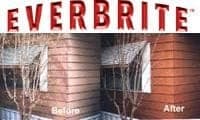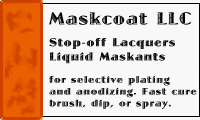
-----
Re-anodizing Aluminum
Q. I have an aluminum catch-can off my car that was anodized black about 8 years ago. I needed to have some new fittings welded to the can, and the result is clear anodized aluminum fittings, bare welds, and the balance is still black. I need to have it re-anodized. I thoroughly washed the can inside & out with solvent followed by dish-soapy water. Can it now be stripped of the previous anodization and re-anodized?
Thank you!!
- Mpls Minnesota
October 11, 2023
A. Hi Bill,
Stripping & re-anodizing should be no problem.
Luck & Regards,

Ted Mooney, P.E. RET
Striving to live Aloha
finishing.com - Pine Beach, New Jersey
Ted can be retained for immediate
answers or long term project help
⇦ Tip: Readers want to learn from your situation;
so some readers skip abstract questions.
Q. How many times can anodize be re-anodized?
AB Biting- Oxnard, California
October 18, 2023
A. Hi AB
The usual situation is that dimensional changes start limiting stripping and re-anodizing because aluminum from the substrate is consumed in building the anodized layer.
Luck & Regards,

Ted Mooney, P.E. RET
Striving to live Aloha
finishing.com - Pine Beach, New Jersey
Ted can be retained for immediate
answers or long term project help
Q. So reading this thread has greatly improved my understanding of anodize, Thanks for that.
I want to Re-anodize to a color some bicycle parts that are older clear anodized. Tolerance is not a concern. My question is the stripping process, is this done chemically or mechanically. If it is chemically can I brush/sand/burnish the surface after stripping before re-anodizing?
Thanks
Hobbyist - Long Beach California
October 18, 2023
A. Hello Jack.
The removal of anodizing is done chemically. Yes, the bare aluminum can be brushed, sanded, burnished, or even polished before re-anodizing.
Luck & Regards,

Ted Mooney, P.E. RET
Striving to live Aloha
finishing.com - Pine Beach, New Jersey
Ted can be retained for immediate
answers or long term project help
Q. Another question if you don't mind. Can existing (older) clear anodize be dyed a color or Can colored anodize be re-dyed to restore the color, without stripping the existing finish?
Jack Miller [returning]br> Hobbyist - Long Beach CaliforniaOctober 19, 2023
A. Hi again Jack.
Sorry, no, that won't work. As a slight simplification, a freshly anodized finish is permeated with millions of microscopic drill holes which extend through the anodized coating, almost to the raw aluminum. These 'straws' get filled with dye, and then the aluminum is sealed (even if not dyed) by immersing it in steam, boiling water, or hot water plus chemicals, which swells the top of the anodizing, closing off those pores.
Luck & Regards,

Ted Mooney, P.E. RET
Striving to live Aloha
finishing.com - Pine Beach, New Jersey
Ted can be retained for immediate
answers or long term project help
⇩ Related postings, oldest first ⇩
Q. Can you re-anodize a piece of aluminum once it has been anodized already? I have a piece with some heavy scratches and scrapes and want to try to make it look a little better. Any suggestions?
Jim Stokes- Richmond, Virginia
2002

Aluminum How-To
"Chromating - Anodizing - Hardcoating"
by Robert Probert
Also available in Spanish
You'll love this book. Finishing.com has sold almost a thousand copies without a single return request :-)
A. It's a very standard practice to strip and re-anodize, Jim, and very often it's no problem.
Usually the only issue is dimensional: about a thousandth of an inch of aluminum is consumed in building a two thousandth of an inch anodized coating. When you strip that coating, the aluminum is lost it doesn't come back. So if the dimensions are critical you can have a problem there.

Ted Mooney, P.E.
Striving to live Aloha
finishing.com - Pine Beach, New Jersey
Ted can be retained for immediate
answers or long term project help
Q. Do I have to strip the first anodized layer to re-anodize the part? Here's my situation. I'm making some pistol grips for a 1911. I have the grips to the shape that I want them. I plan on anodizing and dyeing the grips. then I will use a small diameter drill bit and drill lots of shallow "pits" in a honeycomb pattern. I know that once I drill into the anodized surface, those drill areas will not be anodized anymore. I want to leave them the natural shiny aluminum color, but how do I anodize the "pits"?
Patrick martin- st. marys, Georgia
May 10, 2010
Treatment &
Finishing of
Aluminium and
Its Alloys"
by Wernick, Pinner
& Sheasby

on eBay or Amazon
or AbeBooks
(affil link)
A. Hi, Patrick. I don't believe there is any technical reason that you can't do this, but there can be some problems with technique. Anodizing is not resistant to either acids or alkalis, so it will be a problem to clean those drilled pits.
Also, if you do not want to go to the cost and effort of masking the dyed anodized surface, your second anodize may have some aesthetic effect on the first layer. One layer of anodizing is used as masking for a second layer sometimes, so I'd say it's do-able but that you want to practice your technique on scrap, not on precious parts. Probably better to mask the anodized grip, and drill through the masking.
Good luck!
Regards,

Ted Mooney, P.E.
Striving to live Aloha
finishing.com - Pine Beach, New Jersey
Ted can be retained for immediate
answers or long term project help
Q. A 1950's vintage bus with gold anodized stainless steel exterior panels is beginning to show its age. I don't know much about anodizing- what would you recommend here? The panels cannot be removed, but the anodizing is worn away in some areas...
Pat Robinson- noblesville, Indiana
November 9, 2010
The Sulfuric Acid Process"
by David LaPlantz
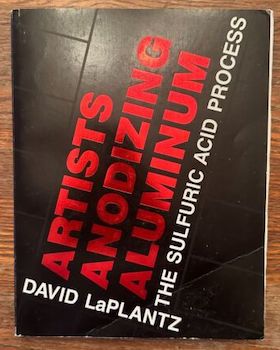
on eBay or Amazon
or AbeBooks
(affil link)
A. Hi, Pat.
First, wash the panels and look at them wet. If they look good enough wet, it may be possible to apply a clearcoat like Everbrite [a finishing.com supporting advertiser] to maintain that wet look.
There are "brush anodizing" services you can retain to do such a project in place, but you may find them prohibitively expensive. An option would be paint that is designed to imitate anodizing. It doesn't really look the same, but may be good enough for a 50 year old bus if you are talking general serviceability as opposed to appearances in car shows. Letter 26417 "True gold anodizing spray paint?" shows real gold anodizing vs. paint that is designed to imitate it. Good luck.
Regards,

Ted Mooney, P.E.
Striving to live Aloha
finishing.com - Pine Beach, New Jersey
Ted can be retained for immediate
answers or long term project help
Re-anodizing the laser etched areas of anodized parts
Q. I have access to a laser cutter and have used it to take off anodization on many things to produce designs and whatnot. I was wondering if I lasered an anodized part could I reanodize the part so that only the newly exposed metal would change color, and the anodization that is still on the metal stay there.
Sullivan Evansstudent - Troy, Michigan, USA
February 27, 2015
Sullivan
I've never tried it on a laser cut surface; only on machined surfaces. I would expect that the 'bare' surface exposed by laser would have a relatively thick oxide film present. Your challenge would be how to remove it and not the existing anodize.
- Colorado Springs, Colorado
Re-anodizing 60 year old aluminum
Q. I am restoring a 1952 International Harvester Refrigerator. The door shelves are aluminum anodized with a gold color. The shelves are then trimmed out with white paint.
The original gold color surface has taken a beating over the years, and the shelves need re-anodizing. I took the pieces to a local Anodizing Company. They told me that the older style aluminum is a different composite than today's aluminum, and that the anodizing process used today (chemicals, etc) is different than what was done "back in the day". They said that there could be a possibility that the resulting gold color could turn out "blotchy". They also weren't keen on painting the white paint over the anodizing because it may not adhere well -- especially if I wanted to follow up with a clear coat paint.
They suggested powder coating as an option instead. Thoughts?
- Butler, Pennsylvania, USA
March 6, 2016
by Runge & Kaufman
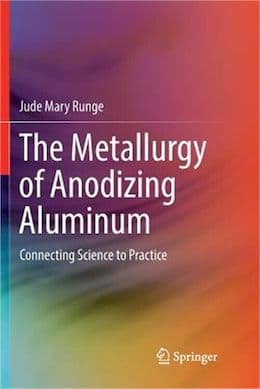
on eBay or Amazon
or AbeBooks
(affil link)
A. Hi, Gary. I think the anodizing shop gave you an honest but slightly misinterpreted answer. I don't think it's a question so much of how aluminum was made 60 years ago vs. how it is made today, but rather the fact that a 60 year old aluminum alloy may by now have separated into its constituents along grain lines such that nice anodizing could be problematic.
Powder coating sounds to me like a practical answer. Good luck.
Regards,

Ted Mooney, P.E. RET
Striving to live Aloha
finishing.com - Pine Beach, New Jersey
Ted can be retained for immediate
answers or long term project help
Q. I have a piece of aluminum 6063 which has been anodized once. I need to machine off some surfaces and perform second anodize. My question is: do I need to strip off / reactivate the first anodic layer on the unmachined surfaces? Or just a neutral pH detergent to remove CNC coolant and then perform second anodize?
Roger Tan- Singapore
January 25, 2019
A. Hi Roger. Best to strip off all of the anodizing, then do the machining, then clean & re-anodize. It's possible to leave the existing anodizing in place and re-anodize the newly exposed aluminum but on onesy-twosy work, with no opportunity for development and testing, it's probably not a safe idea.
Regards,

Ted Mooney, P.E. RET
Striving to live Aloha
finishing.com - Pine Beach, New Jersey
Ted can be retained for immediate
answers or long term project help
|
|
Q. I have a house with large amount of aluminum siding in a purple color. Over time the color has faded unevenly and I want to re-anodize the Aluminium. What process do I follow here? Does it need to be sandblasted first to remove the first layer and then get it anodized? Or would the best option be powder coating it? Trying to consider cost here too since right now I'm completely unaware what it may cost. Marina Shimanski- Washington D.C. February 22, 2019 A. Hi Marina. I strongly doubt that the aluminum siding on a residence was anodized. The siding is probably painted. Look at it when it's wet; if being wet restores the finish sufficiently for you, you can perhaps simply have it clearcoated. If it still looks faded when wet, you can have it prepped & painted by a house painter. Regards,  Ted Mooney, P.E. RET Striving to live Aloha finishing.com - Pine Beach, New Jersey Ted can be retained for immediate answers or long term project help |
Q. Hello, my name is Alex. I have two anodized aluminum pistol frames - one from the late 1905's and one from the early 1960's that have some wear. Since tolerances are important to the internal dimensions, is there a way to anodize the frames but not remove the original anodizing so that only the bare surfaces get "touched up"? Or maybe apply some coating that will prevent the internal surfaces from being anodized? Do you have better advice?
Also, if I remove the anodizing (and therefore, a couple of thousandths of material) and hard anodize, will that build it back up to approx. where it is now?
Anodizing is much more technical than I previously understood!
Thank you.
- Wallingford, Pennsylvania, USA
March 26, 2019
by V. F. Henley
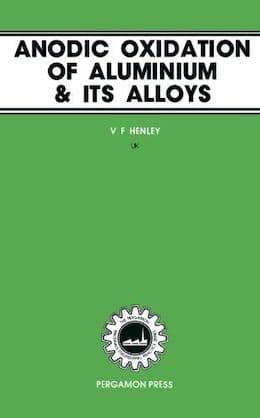
on eBay or Amazon
or AbeBooks
(affil link)
A. Hi Alex. As you say, anodizing is quite technical, so the idea of re-anodizing bare or thin spots without removing the existing anodizing sounds very doubtful. But it may be possible to mask the interior, then strip the coating on the outside and re-anodize it, leaving the interior unaffected as you re-do the outside.
About 0.0001" of aluminum is consumed in building an anodized coating of 0.0002". So, on a diameter (because you are measuring coating thickness twice), after anodizing to 0.0002" thick the diameter will be about 0.0002" larger than you started with. If you started with a diameter of 1", then after anodizing to 0.0002" thick, the diameter will be about 1.0002". If you strip the anodizing, the diameter will be down to 0.9998". If you were to anodize the second time to a thickness of 0.0004", the diameter after anodizing would be 1.0002" again. So it might be theoretically possible to restore the original diameter by anodizing twice as thick the second time around. However, there are three problems:
- first, the buildup is approx. 50%, not exactly;
- second, this would be a job for a high skilled anodizer, not an experimenter;
- third, hard anodizing is usually about 0.002" thick, so if you strip it and lose 0.004" from the diameter, you'd have to re-anodize to a thickness of 0.004" to secure the buildup, and that's probably not practical.
So masking the interior sounds like the most practical approach.
Regards,

Ted Mooney, P.E. RET
Striving to live Aloha
finishing.com - Pine Beach, New Jersey
Ted can be retained for immediate
answers or long term project help
Q. Hi, my name is Caleb. I work for a historic restoration company that is currently on a project restoring an anodized aluminum storefront built in the 30's.
The storefront itself is pretty straight forward. gentle detergent and soft scrubbing seemed to work well. however, there are also ornate cast "screens" that attach to the storefront. These, along with more exposed portions of the storefront, are pretty severely pitted and discolored. I believe these areas have already lost their coating? I'm also concerned that harder scrubbing or sanding may remove, or may have already removed, some of the anodized finish.
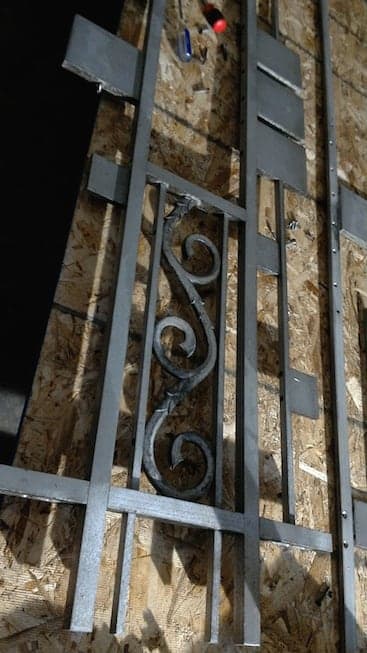
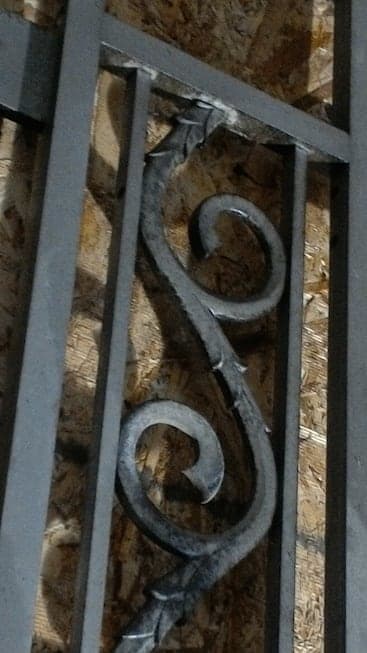
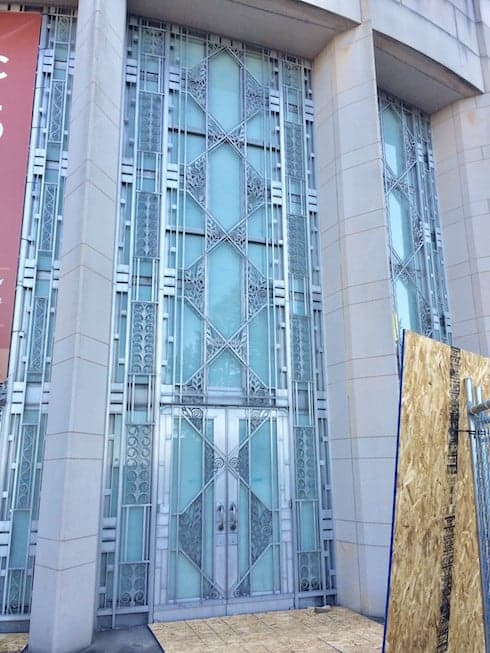
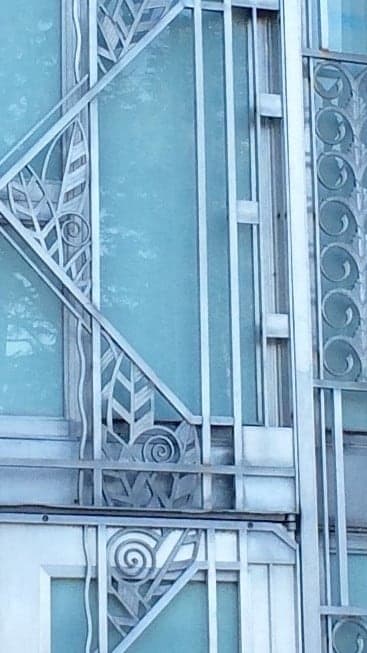
I'm hoping to find the quickest/least expensive solution to cleaning these. Just trying to achieve a cleaner more uniform appearance and address the worst of the pitting. Is it necessary to re-anodize the entire surface? If we just scrubbed and didn't re-anodize anything, what kind of corrosion might I be looking at in the future? Could you clearcoat to help protect the areas that have lost their coating? or would it just be faster and better quality to clean and then re-anodize with some sort of paint on product? any advice is appreciated as aluminum is not something we are used to working on...
Thanks so much,
historic restoration - Seattle, Washington USA
March 29, 2019
by S. Kawai
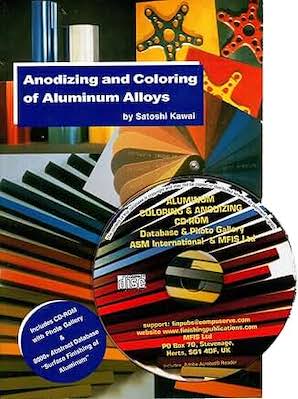
on AbeBooks (rarely)
or eBay (rarely)
or Amazon (rarely)
Not avail. from any of these sources at last check, but links maintained in case a copy turns up :-)
(affil link)
A. Hi Caleb. Quite a beautiful storefront!
Detergent should not hurt anodizing as long as the detergent is not strongly alkaline. And scrubbing should have no effect (it's reasonably hard to remove anodizing with sandpaper).
Re-anodizing pitted material is troublesome, so I'd probably suggest the clearcoating.
adv.
Our supporting advertiser, Everbrite [a finishing.com supporting advertiser] has been involved in significant restoration works per my understanding, and contacting them would probably be worthwhile.
Regards,

Ted Mooney, P.E. RET
Striving to live Aloha
finishing.com - Pine Beach, New Jersey
Ted can be retained for immediate
answers or long term project help
Q. Hello, My name is Anthony and I do building envelope consulting in the NY metro area. I have a large number of aluminum posts and rails I was called in to look at on a high rise building. Due to the way the post attachments were placed, the attachments were failing in part from a block-out and grouting detail used to embed the post.
The system, which also has safety glass panels, is very nice, and I'd prefer to remove the guard rail systems, modify the posts bases to have a welded aluminum alloy plate with pre-drilled holes, and go back with a surface mount detail once the substrate is repaired (and assuming the engineering math allows it to work to code).
Anyhow, with the amount of heat involved from welding base-plates to posts, I'm expecting there to be some distress to the local metal that will require re-finishing to provide a uniform appearance.
So, my questions are:
1) How badly does welding impact an existing anodized finish as far as appearance and performance?
2) If my goal is to have a finished product with a hi-quality aesthetic appearance, is it best to just clean/re-anodize all the modified post extrusions?
Thanks!
Architecture - New York City, New York, USA
May 3, 2019
A. Welding will destroy the anodizing at the weld, and for some distance beyond, depending on the temperature, probably for 1/2" to 1", possibly more.

Jeffrey Holmes, CEF
Spartanburg, South Carolina
Q. What would be a ballpark cost to re-anodize an aluminum frame for a computer keyboard? Estimating a 15"x5" hollow aluminum frame with 1.5" tall "walls" that are ~ 3/8" thick.
R. FriisSargent & Lundy - Chicago, Illinois - USA
June 7, 2019
A. Hi R. Friis. $125 is probably as good a guess as any. Like in most businesses, labor is the largest cost for anodizing, and one-of-a-kind projects involve setup, evaluation, and quality control so most anodizing shops will have a minimum lot charge that could vary from probably $75 at hobbyist level anodizers to $200 or more at shops with NADCAP and other advanced quality systems.
Regards,

Ted Mooney, P.E. RET
Striving to live Aloha
finishing.com - Pine Beach, New Jersey
Ted can be retained for immediate
answers or long term project help
Q. Hello,
I have a few of questions. I recently purchased some anodized aluminum fasteners which are the wrong shade of colour I was looking for.
Is it possible to anodize over the coloured fasteners with the shade I want and will the desired colour show through? Can a shop match the shade from an example I have?
Is better to get non-anodized fasteners and have shop try to match the colour I want from my example? Thanks for your time.
Jay
- Ottawa, ON, CANADA
July 5, 2019
A. Hi Jay. The old anodizing must be stripped, which will remove the dye so nothing will show through. This will change the dimensions, however, because anodizing is not something that goes on top of aluminum like paint or electroplating; rather, anodizing consumes aluminum in making the aluminum oxide coating -- it takes roughly 0.0002" of aluminum to build 0.0004" of anodizing. So when you strip and re-anodize, you lose dimensions. Thus it's important to know what kind of fasteners you are speaking of.
Regards,

Ted Mooney, P.E. RET
Striving to live Aloha
finishing.com - Pine Beach, New Jersey
Ted can be retained for immediate
answers or long term project help
Q. Hi guys my name is mark and my hobby is 1/14 scale r/c tractor trailers. I just bought this trailer and its anodized a really weak color blue. Is it possible to re anodize it a darker blue without having to strip it back to Raw aluminium?

- Mastic beach, New York
July 10, 2019
A. Hi Mark. You must strip back to raw aluminum first. The reason your color is "weak" may not be the dye, but the fact that the anodizing isn't thick enough to absorb enough dye for a fully saturated color.
Regards,

Ted Mooney, P.E. RET
Striving to live Aloha
finishing.com - Pine Beach, New Jersey
Ted can be retained for immediate
answers or long term project help
Q. Hello, My name is Terry and I restore old stereos from the 60's, 70's and 80's. I have an early 1970's Marantz 2230 stereo that has an all aluminum face-plate that has stamped lettering and is anodized with what has been called "Champagne" color. The face unfortunately has been scratched badly in several locations but not in any of the stamped lettering. At one point in time this was sanded down thru the anodizing to bare metal. Can this face-plate be sanded back down on a belt sander and re-anodized with a similar color? I am assuming that the black lettering will have to be repainted on following the anodizing. This is a potentially valuable unit and I would like to get it looking as close to original as possible.
Thank you.
Stereo Restorations - Fort Smith, Arkansas, USA
August 4, 2019
A. Hi Terry. High quality lettering on anodized aluminum is done by anodizing the aluminum, screen printing the lettering so the ink is absorbed into the tiny honeycomb-like pores of the aluminum, then the aluminum is sealed (swelled in boiling water or other chemicals to close off the tops of the pores). Theoretically an anodizing shop could build the necessary silk screens, do the anodizing, apply the ink, and seal the faceplate but it would probably be prohibitively expensive.
It wouldn't be as good an answer, but you could have the face plates anodized, apply chartpak decal lettering yourself, and a high quality clear coating.
Regards,

Ted Mooney, P.E. RET
Striving to live Aloha
finishing.com - Pine Beach, New Jersey
Ted can be retained for immediate
answers or long term project help
Q. Dear sir is it possible to re-anodize already anodized surface of thin aluminium sheet.
murthy psnshop owner - vijayawada,andhra pradesh, India
September 20, 2019
A. Hi Murthy. Yes but :-)
"Thin" is relative and usually, but not always, the anodizing is substantially thinner than the thin sheet. Further, anodizing can take a lot of current and heat up the aluminum, so you must determine that the racking distributes the electricity well since a thin sheet can't carry much.
Regards,

Ted Mooney, P.E. RET
Striving to live Aloha
finishing.com - Pine Beach, New Jersey
Ted can be retained for immediate
answers or long term project help
Q. Sir can I re-anodize a 0.30 mm aluminium sheet. These sheets are printing plates which are already used.
psn murthy [returning]employer - vijayawada, India
A. Hi again, Murthy. Sorry but, although you've given us the thickness of the sheet, your question remains abstract and I don't know how to further clarify my answer, except to also tell you that anodizing is not an additive process like painting or plating where you can strip the coating and start completely over again. In anodizing you consume aluminum in building the aluminum oxide. If your anodized coating is say 8µm thick on each side, about half of that thickness came from the substrate aluminum, so when you strip it the aluminum with be 8µm thinner than when you started; it's worse if your anodized layer is more than 8µm thick, and somewhat better if the coating is thinner.
Please tell us about your shop's anodizing capabilities and how you anodized them the first time around because anodizing thin sheets without burning is tricky. Can we assume you want to use them for printing again? They were used exactly once and you want to use them again? -- or are you talking about scrap collecting? Give us a couple of paragraphs of facts, figures, and data, and somebody will probably be able to advance the answer beyond "maybe" :-)
Luck & Regards,

Ted Mooney, P.E. RET
Striving to live Aloha
finishing.com - Pine Beach, New Jersey
Ted can be retained for immediate
answers or long term project help
Anodizing of aluminium of 0.30 mm thickness
Q. We want to anodize thin aluminium sheet of 0.30 mm, in our process we are using sulfuric acid. But while anodizing the sheet is thinning. Please advise.
Psn Murthy [returning]- Andhra-pradesh, Vijayawada, India
December 14, 2019
A. Hi Psn. Although there may be additional problems in your process, like poor contacts that are causing burning, or inefficient caustic soda ⇦liquid caustic soda in bulk on Amazon [affil link] stripping which is wasting aluminum, it seems that the main problem may be that you are misunderstanding a principal situation about anodizing. Anodizing is not a coating you put on top of your aluminum, it is a "conversion process" which turns the aluminum on the surface of your sheet into aluminum oxide and related compounds; the aluminum portion of that coating comes from the sheet -- it can't come from anywhere else.
If you do a .01 mm (0.0004") anodized coating on each side of that sheet, you're going to lose about .005 mm of aluminum from each side of the sheet or .01 mm total. If you then strip the anodized coating with a perfect stripper that does not waste or lose any aluminum at all, your sheet is going to be .29 mm, not .30 mm.
I know that aluminum printing plates must be properly grained (the surface made into sort of a sponge so it is highly hydrophillic) before anodizing but, sorry, I do not know enough about printing plates to know whether in the course of stripping the anodizing the usefulness of the graining is compromised such that you must re-grain as well, nor whether it is conventional to strip and re-use such plates.
No readers have responded to your postings in 3 months now. Please try to attract their interest by telling us how thick an anodized coating you are trying to apply to this .300 mm thick sheet, how thick the sheet measures after you've done so, what material/process you are using to strip the anodizing, how thick the sheet is after stripping, and some hints about what you think might be thinning the plates ... and give us a general introduction to your process and overall situation which explains how you are handling this coil or these cut sheets that you are trying to re-use. Then hopefully readers will help you assess whether you are doing anything wrong or not. Thanks!
Regards,

Ted Mooney, P.E. RET
Striving to live Aloha
finishing.com - Pine Beach, New Jersey
Ted can be retained for immediate
answers or long term project help
Q. I just purchased a vintage, gold anodized motorcycle swingarm, manufactured by a copy called DG in the late 1970's. The part is weathered, scratched and worn.
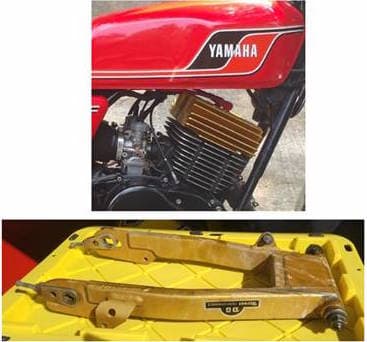
I would like to have it reanodized to match the like new cylinder head from the same DG company that is currently on the motorcycle. Is it possible to color match the aged swingarm to the like new head?
Steven LiberatoreYamaha Motor Corp USA - Acworth Georgia
October 28, 2019
|
|
A. It is definitely possible, but may be very challenging for your anodizer. The main reason being is that the 2 alloys are probably not the same. Anodizing colors, especially the lighter ones like gold can be dependent on alloy, surface finish, and coating thickness. My approach if I were you would be to take your swing arm down to a professional anodizer, and have them show you what colors they offer. Once agreed upon, the swing arm will have to be stripped, any non-aluminum hardware removed, polished, and then reanodized. Your anodizer may not guarantee an exact color match, but should be able to come close.  Marc Green anodizer - Boise, Idaho A. Yes, it looks like it could use a little restoration before anodize but you could certainly get close on color. Looks to be a FAO / FSO inorganic dye. Those dyes produce a nice looking gold color - lightfast too, which would be perfect for this situation. Taylor Clarke- Minden Nevada |
Q. Hi, I'm Rodney,
I dabble in a little bit of everything. But since retiring, I've focused on restoration and building of weapons. I have some aluminum 7075 AR15 lowers that have been anodized on the exterior. I have to finish the machining on the inside chamber, which will expose unfinished aluminum. My first thought was to tape off the exterior and just Cerakote the inside for protection. I have read some of the questions and answers on re-anodizing exposed parts to also cover the freshly machined areas. I noticed that a few of the replies, stated to tape off the anodized areas that have already been finished and then anodize the new areas. How do i accomplish this? What type of tape do i use that Won't be destroyed during the process? I have no problem using Cerakote, i just wanted a more durable finish for the moving parts.
Sincerely
- Cabot Arkansas
October 8, 2020
A. Hi Rodney. I'm not familiar enough with AR15 lowers to know whether stripping the existing anodizing and re-doing it (which is probably the easier approach) would cause dimensional problems, but as for masking finished areas, the general rule is that vinyl is resistant to most stuff in a plating or anodizing shop ...
So vinyl caps or plugs, if they fit, are one answer. Vinyl 'platers tape' similar to electricians tape but thicker can work if the area can be wrapped. Other than that there are liquid maskants made for the purpose.
Luck & Regards,

Ted Mooney, P.E. RET
Striving to live Aloha
finishing.com - Pine Beach, New Jersey
Ted can be retained for immediate
answers or long term project help
QUICKSTART:
Anodizing of aluminum is different dimensionally than most other finishing processes because the aluminum portion of the aluminum oxide surface you are creating comes from the substrate and therefore permanently reduces its dimensions. When you do anodizing of, say, 0.0004" thickness, you consume approximately 0.0002" of aluminum in doing so (roughly 50%).
So the first time you anodize a surface to 0.0004" thickness, it's dimension only grows by about 0.0002" because the substrate was reduced by about 0.0002".
If you re-anodize it, first you must strip it, which will leave it about 0.0002" shy of it's original dimension, then when you anodize 0.0004" thick again, about another 0.0002" of aluminum is consumed and your finished dimensions will be about the same as before you started any anodizing :-)
Q. I engrave after anodize to have bright aluminum colored lettering show through. I made a mistake on just a few parts. The part is basically a block with holes drilled in it and slots cut with an end mill that has been anodized black. I plan to face off the side with the mistaken engraving and re-anodize black. Dimensions and build up doesn't matter. Will the re-anodize surface resemble the already anodized surface.
Will it be presentable and structurally sound.
- Monrovia California
December 29, 2020
A. Hi Mario. Sorry but I'm not sure what you mean by "face off the side with the mistaken engraving and re-anodize". If you mean you want to mask off everything else except that one side, then strip the anodizing on that one side, and re-do it ... well, it's possible; but when dimensions aren't critical that's more complicated and probably more expensive than simply stripping off all the anodizing and re-doing the whole thing -- which will give you a better quality product and a more consistent look.
Luck & Regards,

Ted Mooney, P.E. RET
Striving to live Aloha
finishing.com - Pine Beach, New Jersey
Ted can be retained for immediate
answers or long term project help
Q. Have an older gun with worn and unsightly pink anodize on the aluminum frame. What are easy options to remove the pink anodize and re-anodize clear or ? Thanks.
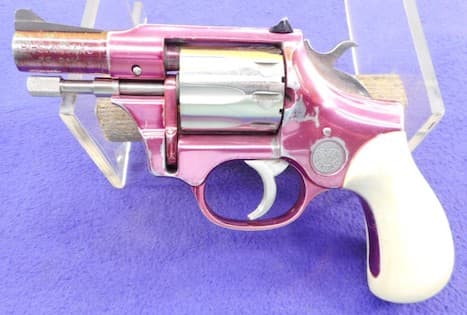
- SANTA FE, New Mexico
February 25, 2021
A. Hi Michael. The method is pretty straightforward: strip the existing anodizing in caustic soda ⇦liquid caustic soda in bulk on Amazon [affil link] or, if dimensions are critical, search the site for "strip anodizing with chromic-phosphoric acid", and strip with that; then do type II anodizing of appropriate thickness. But 'easy' is relative and dependent upon your experience and supplies. If you have no previous experience stripping & anodizing, and you insist on doing it yourself rather than sending it to an anodizing shop, I would urge you to acquire some successful experience working on scrap rather than practicing on something valuable to you.
Luck & Regards,

Ted Mooney, P.E. RET
Striving to live Aloha
finishing.com - Pine Beach, New Jersey
Ted can be retained for immediate
answers or long term project help
⇦ Tip: Readers want to learn from your situation;
so some readers skip abstract questions.
Q. Hello! I was wondering if it's possible to tell if a part has been "Hard" anodized as opposed to regular anodizing?
Thanks in advance.
Mars
hobbyist - Eugene Oregon
April 26, 2021
A. Hi Mars. The single biggest difference is the thickness of the anodizing. If it's about 0.002" it's essentially hard anodizing (although there is more to qualifying as proper hard anodizing than just the thickness); if the thickness is more like 0.0002-0.0007" it's probably conventional Type II anodizing.
Luck & Regards,

Ted Mooney, P.E. RET
Striving to live Aloha
finishing.com - Pine Beach, New Jersey
Ted can be retained for immediate
answers or long term project help
Q. Good Day Sir,
I'm needing to strip and re-anodize a part that has holes that must retain a strict tolerance. my fear is stripping them and losing tolerance during the strip process. If i mask the holes for stripping and un mask and re anodize the part will it cause the holes to "burn" its type 2 class 1 clear sealed anodize. Thank you for your time.
Lead Anodizer - Lakeland, Florida
October 29, 2021
A. Hi James. I would not expect that to cause burning, but let's see if anyone with hands-on knowledge of that situation can help. I'm curious, though, why you wouldn't wait until the re-anodizing is complete before removing the masking.
Luck & Regards,

Ted Mooney, P.E. RET
Striving to live Aloha
finishing.com - Pine Beach, New Jersey
Ted can be retained for immediate
answers or long term project help
A. James
Ted is absolutely correct. You do not normally encounter burning when anodizing a stripped part that has portions of the part still anodized. Anodize does not build up on an anodized surface. Also, while it may entail a little bit of extra rinsing around the masking then, you could take his advice and leave the plugs in until completed.
Also if you would like to test this out for yourself why not find a scrap part or an aluminum panel, remove the anodize partway and then re-anodize so you can see the results first hand.
supervisor - Cicero, Illinois
Saporito Finishing Co.
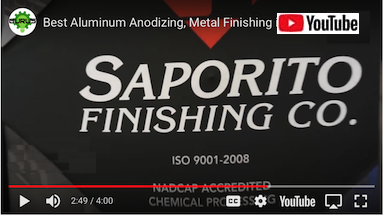
A. One or two bars/parts can be stripped by caustic soda ⇦liquid caustic soda in bulk on Amazon [affil link] as check the tolerance loss. So if you see the losing tolerance I would advice you to "acidic stripping process" which used sulfuric acid and chromic acid. I don't want to write formulation of bath due to forum rules. Unlike from caustic soda based stripping in acidic formulation only anodizing layer is stripped, aluminium surface is not affected.
Alaattin Tuna- sakarya TURKEY
Ed. note: Clarifying Alaattin's reference to 'forum rules': this is a 'no registration' site so we worry about posting formulas & mixes which might be trade secret (perhaps posted by a disgruntled employee using a fictitious name). But the phosphoric-chromic stripping solution is a well known generic formulation, and Alaattin is well known to the readers, so it's no problem in this case :-)
A. It is possible for the existing anodize to breakdown and create a burn during a re-anodize. Aluminum alloys in the 70 series can be particularly susceptible. To minimize this possibility, make sure you have an excellent seal on the original anodize. Keep the anodize voltage at or below that used in the original processing.
Chris Jurey, Past-President IHAALuke Engineering & Mfg. Co. Inc.
Wadsworth, Ohio

![]() Thank you sirs, for your help. I took your advice, all worked great!
Thank you sirs, for your help. I took your advice, all worked great!
Q. Alaattin, that's interesting can you post the formula that you're speaking about?
James Driscoll [returning]Lead Anodizer - Lakeland, Florida [returning]
November 5, 2021
A. Hi James. Alaattin's formula may be a sulfuric-chromic acid stripping solution, or he might have made a typo and was referencing a traditional phosphoric-chromic acid stripping solution, the formula for which is given by Phil Johnson in topic 2776 and by Greg Haataja and Art Kushner in topic 3397.
Luck & Regards,

Ted Mooney, P.E. RET
Striving to live Aloha
finishing.com - Pine Beach, New Jersey
Ted can be retained for immediate
answers or long term project help
Q, A, or Comment on THIS thread -or- Start a NEW Thread

